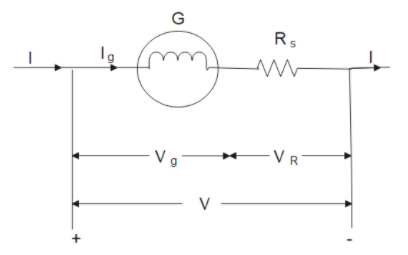
The conversion of a moving coil galvanometer into a voltmeter is done by
A.Introducing a large value of resistance in series
B.Introducing a resistance of small value in parallel.
C.Introducing a resistance of large value in parallel.
D.Introducing a resistance of small value in series.
Answer
558.6k+ views
Hint: A permanent magnet moving coil (PMMC) instrument in series with high resistance is known as voltmeter. Voltmeter is always connected in parallel with the points across which potential difference is to be measured,
Formula:
${{R}_{s}}=G(n-1)$
$n=\dfrac{V}{{{V}_{g}}}$
Complete answer:
Moving coil galvanometer is a very sensitive and delicate instrument and can give a full-scale deflection for small potential difference applied across its terminals. Hence to measure large potential difference, effective resistance of the instrument should be high. This can be achieved by connecting a high resistance in series with a moving coil galvanometer. If resistance is not connected and a high potential is applied across the terminals of PMMC then a high current will flow through the coil, which may result in burning of the instrument due to excessive heat produced. The moving coil galvanometer will be protected from such probable damage, if high resistance is connected in series with the moving coil galvanometer.
Conversion diagram of moving coil galvanometer to voltmeter is shown below

Hence we conclude that the conversion of a moving coil galvanometer into a voltmeter is done by introducing a large value of resistance in series.
The value of resistance can be found out by the formula ${{R}_{s}}=G(n-1)$
G is the resistance of galvanometer and $n=\dfrac{V}{{{V}_{g}}}$
Hence, Option(A) is correct.
Additional information:
A Galvanometer is converted into ammeter by connecting a low resistance in parallel with a galvanometer. This resistance is also known as shunt resistance. The value of resistance is so adjusted such that maximum current flows through the shunt branch. Thus galvanometer can be converted into ammeter or voltmeter as per requirement.
Note:
Remember that a high value of resistance must be connected in series with the moving coil galvanometer to increase the resistance. A small resistance that is called a shunt is connected in parallel with the galvanometer to reduce the resistance.
Formula:
${{R}_{s}}=G(n-1)$
$n=\dfrac{V}{{{V}_{g}}}$
Complete answer:
Moving coil galvanometer is a very sensitive and delicate instrument and can give a full-scale deflection for small potential difference applied across its terminals. Hence to measure large potential difference, effective resistance of the instrument should be high. This can be achieved by connecting a high resistance in series with a moving coil galvanometer. If resistance is not connected and a high potential is applied across the terminals of PMMC then a high current will flow through the coil, which may result in burning of the instrument due to excessive heat produced. The moving coil galvanometer will be protected from such probable damage, if high resistance is connected in series with the moving coil galvanometer.
Conversion diagram of moving coil galvanometer to voltmeter is shown below

Hence we conclude that the conversion of a moving coil galvanometer into a voltmeter is done by introducing a large value of resistance in series.
The value of resistance can be found out by the formula ${{R}_{s}}=G(n-1)$
G is the resistance of galvanometer and $n=\dfrac{V}{{{V}_{g}}}$
Hence, Option(A) is correct.
Additional information:
A Galvanometer is converted into ammeter by connecting a low resistance in parallel with a galvanometer. This resistance is also known as shunt resistance. The value of resistance is so adjusted such that maximum current flows through the shunt branch. Thus galvanometer can be converted into ammeter or voltmeter as per requirement.
Note:
Remember that a high value of resistance must be connected in series with the moving coil galvanometer to increase the resistance. A small resistance that is called a shunt is connected in parallel with the galvanometer to reduce the resistance.
Recently Updated Pages
Why are manures considered better than fertilizers class 11 biology CBSE

Find the coordinates of the midpoint of the line segment class 11 maths CBSE

Distinguish between static friction limiting friction class 11 physics CBSE

The Chairman of the constituent Assembly was A Jawaharlal class 11 social science CBSE

The first National Commission on Labour NCL submitted class 11 social science CBSE

Number of all subshell of n + l 7 is A 4 B 5 C 6 D class 11 chemistry CBSE

Trending doubts
What is meant by exothermic and endothermic reactions class 11 chemistry CBSE

10 examples of friction in our daily life

One Metric ton is equal to kg A 10000 B 1000 C 100 class 11 physics CBSE

1 Quintal is equal to a 110 kg b 10 kg c 100kg d 1000 class 11 physics CBSE

Difference Between Prokaryotic Cells and Eukaryotic Cells

What are Quantum numbers Explain the quantum number class 11 chemistry CBSE




